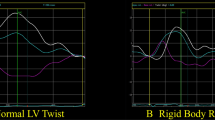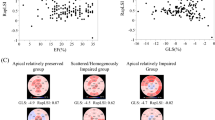Abstract
In idiopathic dilated cardiomyopathy (DCM), myocardial deformational parameters and their relationships remain incompletely characterized. We measured those parameters in patients with DCM, during left ventricular reverse remodeling (LVRR). Prospective study of 50 DCM patients (in sinus rhythm), with left ventricular ejection fraction (EF) <40%. LVRR was defined as an increase of ten units of EF and decrease of diastolic left ventricular diameter (LVDD) in the absence of resynchronization therapy. Performed morphological analysis, myocardial performance quantification (LV and RV Tei indexes) and LV averaged peak systolic longitudinal strain (SSR long) and circumferential strain (SSR circ). At baseline, mean EF was 25.4 ± 9.8%, LVDD was 62.4 ± 7.4 mm, LVDD/BSA of 34.2 ± 4.5 mm/m2 and 34% had MR grade >II/IV. LVRR occurred in 34% of patients within 17.6 ± 15.6 months and was associated with a reduced rate of death or heart failure hospitalization (5.9% vs. 33.3; p = 0.03). Patients with LVRR had a final EF of 48.9 ± 7.9% (Δ LV EF of 22.4%) and there was a significant decrease (p < 0.05) in: LVDD/BSA, LV systolic diameter/BSA, LV diastolic volume, LV systolic volume, LV mass; an increase (p < 0.05) in sphericity index. However, measures of diastolic function (LA volume/BSA, e′velocity and’ E/e′ratio), final LV and RV Tei indexes were not significantly different from baseline. Additionally, final SSR circ and SSR long values were not different from basal. Patients who recovered EF >50% (n = 10), SSR circ and SSR long were inferior to normal. Improvement in EF occurred in one-third of DCM pts and was associated with a decrease of major cardiac events. There was an improvement of diastolic and systolic volumes and in sphericity index, confirming truly LV reverse reshaping. However, myocardial performance indexes, SSR long and SSR circ in reverse-remodeled DCM were still abnormal, suggesting a maintained myocardial systolic and diastolic dysfunction.

Similar content being viewed by others
References
Cohn JN, Ferrari R, Sharpe N (2000) Cardiac remodeling–concepts and clinical implications: a consensus paper from an international forum on cardiac remodeling. Behalf of an International Forum on cardiac remodeling. J Am Coll Cardiol 35(3):569–582
Groenning BA, Nilsson JC, Sondergaard L, Fritz-Hansen T, Larsson HB, Hildebrandt PR (2000) Antiremodeling effects on the left ventricle during beta-blockade with metoprolol in the treatment of chronic heart failure. J Am Coll Cardiol 36(7):2072–2080
Greenberg B, Quinones MA, Koilpillai C, Limacher M, Shindler D, Benedict C et al (1995) Effects of long-term enalapril therapy on cardiac structure and function in patients with left ventricular dysfunction. Results of the SOLVD echocardiography substudy. Circulation 91(10):2573–2581
Arnold RH, Kotlyar E, Hayward C, Keogh AM, Macdonald PS (2003) Relation between heart rate, heart rhythm, and reverse left ventricular remodelling in response to carvedilol in patients with chronic heart failure: a single centre, observational study. Heart 89(3):293–298
Boccanelli A, Mureddu GF, Cacciatore G, Clemenza F, Di Lenarda A, Gavazzi A et al (2009) Anti-remodelling effect of canrenone in patients with mild chronic heart failure (AREA IN-CHF study): final results. Eur J Heart Fail 11(1):68–76
Kubo H, Margulies KB, Piacentino V 3rd, Gaughan JP, Houser SR (2001) Patients with end-stage congestive heart failure treated with beta-adrenergic receptor antagonists have improved ventricular myocyte calcium regulatory protein abundance. Circulation 104(9):1012–1018
Lupon J, Gaggin HK, de Antonio M, Domingo M, Galan A, Zamora E et al (2015) Biomarker-assist score for reverse remodeling prediction in heart failure: the ST2-R2 score. Int J Cardiol 184:337–343
Tei C, Ling LH, Hodge DO, Bailey KR, Oh JK, Rodeheffer RJ et al (1995) New index of combined systolic and diastolic myocardial performance: a simple and reproducible measure of cardiac function–a study in normals and dilated cardiomyopathy. J Cardiol 26(6):357–366
Su HM, Lin TH, Voon WC, Lee KT, Chu CS, Yen HW et al (2006) Single-beat differentiation among left ventricular filling patterns by pulsed wave Doppler echocardiography. J Am Soc Echocardiogr 19(3):274–279
Marwick TH (2006) Measurement of strain and strain rate by echocardiography: ready for prime time? J Am Coll Cardiol 47(7):1313–1327
Yu CM, Lin H, Fung WH, Zhang Q, Kong SL, Sanderson JE (2003) Comparison of acute changes in left ventricular volume, systolic and diastolic functions, and intraventricular synchronicity after biventricular and right ventricular pacing for heart failure. Am Heart J 145(5):E18
Soliman OI, van Dalen BM, Theuns DA, ten Cate FJ, Nemes A, Jordaens LJ et al (2009) The ischemic etiology of heart failure in diabetics limits reverse left ventricular remodeling after cardiac resynchronization therapy. J Diabetes Complicat 23(5):365–370
Amorim S, Campelo M, Martins E, Moura B, Sousa A, Pinho T et al (2016) Prevalence, predictors and prognosis of ventricular reverse remodeling in idiopathic dilated cardiomyopathy. Revista portuguesa de cardiologia 35(5):253–260
McMurray JJ, Adamopoulos S, Anker SD, Auricchio A, Bohm M, Dickstein K et al (2012) ESC guidelines for the diagnosis and treatment of acute and chronic heart failure 2012: The task force for the diagnosis and treatment of acute and chronic heart failure 2012 of the european society of cardiology. Developed in collaboration with the heart failure Association (HFA) of the ESC. Eur Heart J 33(14):1787–1847
Puri KS, Suresh KR, Gogtay NJ, Thatte UM. (2009) Declaration of Helsinki, 2008: implications for stakeholders in research. J Postgrad Med.55(2):131–134
von Elm E, Altman DG, Egger M, Pocock SJ, Gotzsche PC, Vandenbroucke JP (2007) The Strengthening the Reporting of Observational Studies in Epidemiology (STROBE) statement: guidelines for reporting observational studies. Ann Intern Med 147(8):573–577
Lang RM, Badano LP, Mor-Avi V, Afilalo J, Armstrong A, Ernande L et al (2015) Recommendations for cardiac chamber quantification by echocardiography in adults: an update from the American Society of Echocardiography and the European Association of Cardiovascular Imaging. J Am Soc Echocardiogr 1–39(1):e14
Devereux RB, Alonso DR, Lutas EM, Gottlieb GJ, Campo E, Sachs I et al (1986) Echocardiographic assessment of left ventricular hypertrophy: comparison to necropsy findings. Am J Cardiol 57(6):450–458
Yingchoncharoen T, Agarwal S, Popovic ZB, Marwick TH (2013) Normal ranges of left ventricular strain: a meta-analysis. J Am Soc Echocardiogr 26(2):185–191
Tei C, Dujardin KS, Hodge DO, Bailey KR, McGoon MD, Tajik AJ et al (1996) Doppler echocardiographic index for assessment of global right ventricular function. J Am Soc Echocardiogr 9(6):838–847
Dujardin KS, Tei C, Yeo TC, Hodge DO, Rossi A, Seward JB (1998) Prognostic value of a Doppler index combining systolic and diastolic performance in idiopathic-dilated cardiomyopathy. Am J Cardiol 82(9):1071–1076
Ikeda R, Yuda S, Kobayashi N, Nakahara N, Nakata T, Tsuchihashi K et al (2001) [Usefulness of right ventricular Doppler index for predicting outcome in patients with dilated cardiomyopathy]. J Cardiol 37(3):157–164
Okada M, Tanaka H, Matsumoto K, Ryo K, Kawai H, Hirata K-i (2012) Subclinical myocardial dysfunction in patients with reverse-remodeled dilated cardiomyopathy. J Am Soc Echocardiogr 25(7):726–732
Yip G, Abraham T, Belohlavek M, Khandheria BK (2003) Clinical applications of strain rate imaging. J Am Soc Echocardiogr 16(12):1334–1342
D’Hooge J, Heimdal A, Jamal F, Kukulski T, Bijnens B, Rademakers F et al (2000) Regional strain and strain rate measurements by cardiac ultrasound: principles, implementation and limitations. Eur J Echocardiogr 1(3):154–170
Cho GY, Marwick TH, Kim HS, Kim MK, Hong KS, Oh DJ (2009) Global 2-dimensional strain as a new prognosticator in patients with heart failure. J Am Coll Cardiol 54(7):618–624
Stanton T, Leano R, Marwick TH. Prediction of all-cause mortality from global longitudinal speckle strain: comparison with ejection fraction and wall motion scoring. Cir Cardiovasc Imaging. 2009;2(5):356–64
Nahum J, Bensaid A, Dussault C, Macron L, Clemence D, Bouhemad B et al (2010) Impact of longitudinal myocardial deformation on the prognosis of chronic heart failure patients. Circ Cardiovasc Imaging 3(3):249–56
Mottram PM, Haluska B, Leano R, Cowley D, Stowasser M, Marwick TH (2004) Effect of aldosterone antagonism on myocardial dysfunction in hypertensive patients with diastolic heart failure. Circulation 110(5):558–565
Ikeda Y, Inomata T, Iida Y, Iwamoto-Ishida M, Nabeta T, Ishii S et al (2016) Time course of left ventricular reverse remodeling in response to pharmacotherapy: clinical implication for heart failure prognosis in patients with idiopathic dilated cardiomyopathy. Heart Vessels 31(4):545–554
Basuray A, French B, Ky B, Vorovich E, Olt C, Sweitzer NK et al (2014) Heart failure with recovered ejection fraction: clinical description, biomarkers, and outcomes. Circulation 129(23):2380–2387
Moon J, Ko YG, Chung N, Ha JW, Kang SM, Choi EY et al (2009) Recovery and recurrence of left ventricular systolic dysfunction in patients with idiopathic dilated cardiomyopathy. Can J Cardiol 25(5):e147–e150
Funding
The funding was provided by Portuguese Society Cardiology.
Author information
Authors and Affiliations
Corresponding author
Ethics declarations
Conflict of interest
None.
Rights and permissions
About this article
Cite this article
Amorim, S., Rodrigues, J., Campelo, M. et al. Left ventricular reverse remodeling in dilated cardiomyopathy- maintained subclinical myocardial systolic and diastolic dysfunction. Int J Cardiovasc Imaging 33, 605–613 (2017). https://doi.org/10.1007/s10554-016-1042-6
Received:
Accepted:
Published:
Issue Date:
DOI: https://doi.org/10.1007/s10554-016-1042-6




